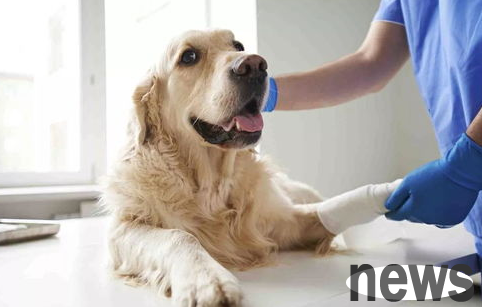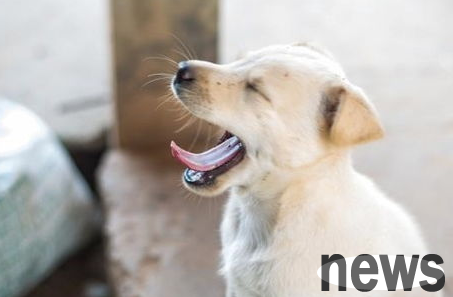Dogs are animals after all, so they are still wild. Sometimes when they see similar or natural enemies, they will fight, or they will cause trauma to the dog due to various accidents. If the dog's head is injured, how should we provide first aid...
Dogs are animals after all, so they are still wild. Sometimes when they see similar or natural enemies, they will fight, or they will cause trauma to the dog due to various accidents. If the dog's head is injured, how should we provide first aid for the dog's head trauma?
1. Case introduction
Teddy, male, one year old, 5kg, body temperature 38.5℃. The day before the treatment, he hit the wall and was stabbed by a foreign object on his forehead. He fainted on the spot and was in a good state when he was in the hospital.

2. Diagnosis treatment: When diagnosing, observe whether the dog's mental state, exercise is normal, whether the wound is contaminated, whether there are foreign objects in the wound, and take an X-ray to observe whether there are foreign objects in the skull. After examination, it was found that the dog was walking normally, with head infection and wounds, and there were not many exudates (see Figure 2). Imaging examination revealed that the skull was intact and there were no foreign objects (see Figure 3).
After general anesthesia of the diseased dog, the wound part is shaved and the iodine tincture is disinfected. The trauma area was rinsed with hydrogen peroxide, 0.9% normal saline (250ml) ceftifuro (0.1g) and iodine. Ceftifuro (25mg) and dexamethasone (0.25ml) were injected subcutaneously for seven days, and A-Parke anti-inflammatory ointment was used for anti-inflammatory treatment. Then hemostatic treatment was performed after subcutaneous injection of vitamin K (0.5ml) and phenolsulfoethylamine (1ml). Finally, 5% glucose sodium chloride injection (250ml), 50% glucose injection (5ml), ATP (0.2ml), Coenzyme A (50U units), and gentamicin (0.5ml) were intravenously injected to correct the imbalance between water and electrolytes.
The wound is mildly infected, after thorough debridement, the wound is trimmed, sterile surgical sutures, external ointment is applied, and the wound is disinfected and changed every day. Detach the stitches for 7-10 days depending on the healing condition.
3. Trauma treatment measures and principles
Trauma can be divided into fresh and old creation according to the time elapsed after injury. The fresh storm is short after the injury time, and there is still blood flowing out of the storm or blood clots exist. The contours of the tissues in the storm can still be identified. Some are seriously infected, but no traumatic infection symptoms appear. The old trauma is a long time after injury, and the contours of the tissues in the trauma are not easy to identify, and obvious symptoms of trauma infection appear. Some excrete pus, while others have granulation tissue. Trauma is divided into sterile wounds, contaminated wounds, and infectious wounds according to the presence or absence of infection. Although the pollution invasion is contaminated by bacteria and foreign bodies, it does not invade the deep tissue to develop and reproduce. The infection invasion is a large number of pathogenic bacteria in the invasion, which has a pathogenic effect on the body.
1. The general principles of trauma treatment are:
① Anti-shock. Anti-shock first, and then debridement surgery is performed after the shock has improved. However, for major bleeding, chest wall penetration wounds and intestinal abduction, surgical treatment should be performed while actively resisting shock.
② Prevent and treat infections. Antibiotics should be started immediately after injury to prevent suppurative infections and cooperate with local treatment.

③Correct water and electrolyte disorders
④Eliminate factors that affect wound healing
⑤ Strengthen feeding management, supplement sufficient nutrition, improve resistance, and promote wound healing. For severe trauma, high-protein and vitamin-rich feed should be given.
2. Basic methods of trauma treatment
① Craft cleaning: Sterilized gauze covers the wound, cleans the hair removal and soapy water around the wound, and disinfects the iodine tincture.
②Wound cleaning: Remove foreign objects, blood clots or pus scabs from the wound, and repeatedly clean the wound until it is cleaned.
③ Debridement surgery: Remove all inactive tissues in the wound, remove visible foreign objects, eliminate the wound capsule, concave wall, expand the wound mouth, and ensure smooth discharge.
④ Trauma medications to prevent trauma infection, accelerate inflammation purification, and promote nuclear epithelial regeneration of granulation tissue.
⑤ Trauma suture
⑥ Trauma drainage When the cavity is deep, the Taoist priest, there are necrotic tissues or low retention exudates in the invasion, etc., drainage strips can be used to promote fluid discharge.
⑦ Trauma bandage Keep the trauma quiet.
⑧ Systemic treatment: Use antibiotics to control inflammation and prevent secondary infections.